Appearance colorless gas IUPAC ID Phosphane Molar mass 33.99758 g/mol Soluble in Water | Formula PH3 Boiling point -87.7 °C Melting point -132.8 °C | |
 | ||
Related compounds Molecular shape Trigonal pyramidal molecular geometry | ||
Preperation of phosphine
Phosphine (IUPAC name: phosphane) is the compound with the chemical formula PH3. It is a colorless, flammable, toxic gas and pnictogen hydride. Pure phosphine is odorless, but technical grade samples have a highly unpleasant odor like garlic or rotting fish, due to the presence of substituted phosphine and diphosphane (P2H4). With traces of P2H4 present, PH3 is spontaneously flammable in air, burning with a luminous flame. Phosphines are also a group of organophosphorus compounds with the formula R3P (R = organic derivative). Organophosphines are important in catalysts where they complex to various metal ions; complexes derived from a chiral phosphine can catalyze reactions to give chiral, enantioenriched products.
Contents
- Preperation of phosphine
- Phosphine ph3 lewis dot structure
- History
- Structure and properties
- Preparation and occurrence
- Laboratory routes
- Occurrence
- Phosphines
- Primary phosphines
- Secondary phosphines
- Tertiary phosphines
- Organophosphorus chemistry
- Microelectronics
- Fumigant
- Safety
- References
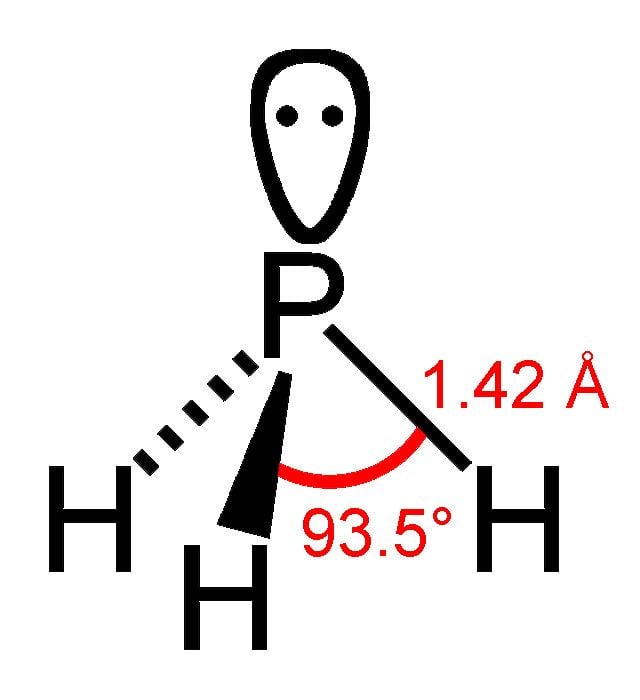
Phosphine ph3 lewis dot structure
History

Philippe Gengembre (1764-1838), a student of Lavoisier, first obtained phosphine in 1783 by heating phosphorus in an aqueous solution of potash (potassium carbonate).
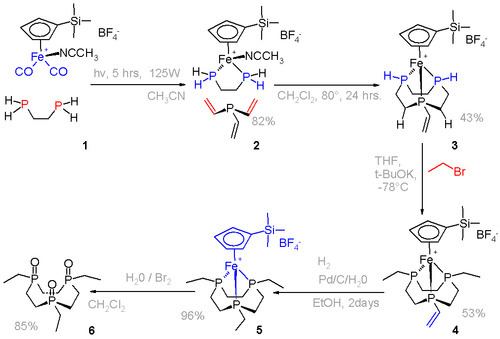
Perhaps because of its strong association with elemental phosphorus, phosphine was once regarded as a gaseous form of the element, but Lavoisier (1789) recognised it as a combination of phosphorus with hydrogen and described it as phosphure d'hydrogène (phosphide of hydrogen).
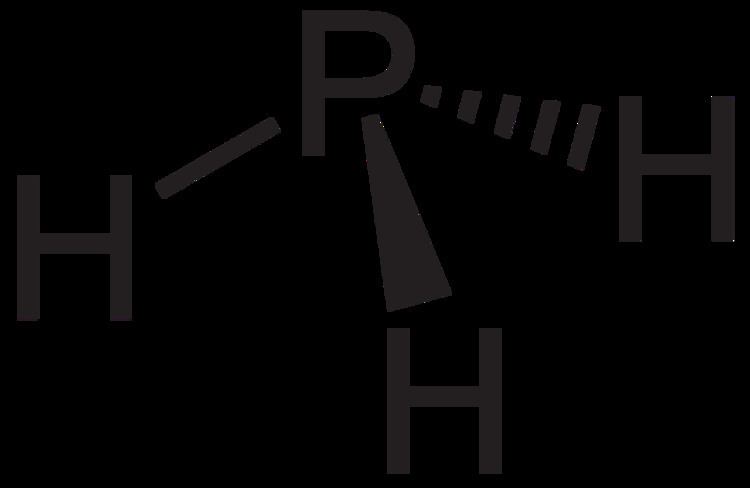
In 1844, Paul Thénard, son of the French chemist Louis Jacques Thénard, used a cold trap to separate diphosphine from phosphine that had been generated from calcium phosphide, thereby demonstrating that P2H4 is responsible for spontaneous flammability associated with PH3, and also for the characteristic orange/brown color that can form on surfaces, which is a polymerisation product. He considered diphosphine’s formula to be PH2, and thus an intermediate between elemental phosphorus, the higher polymers, and phosphine. Calcium phosphide (nominally Ca3P2) produces more P2H4 than other phosphides because of the preponderance of P-P bonds in the starting material.
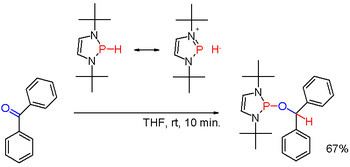
The name "phosphine" first appeared in combined form in 1857. The gas PH3 was named "phosphine" by 1865 (or earlier).
Structure and properties
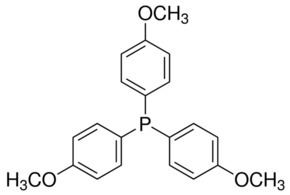
PH3 is a trigonal pyramidal molecule with C3v molecular symmetry. The length of the P-H bond is 1.42 Å, the H-P-H bond angles are 93.5°. The dipole moment is 0.58 D, which increases with substitution of methyl groups in the series: CH3PH2, 1.10 D; (CH3)2PH, 1.23 D; (CH3)3P, 1.19 D. In contrast, the dipole moments of amines decrease with substitution, starting with ammonia, which has a dipole moment of 1.47 D. The low dipole moment and almost orthogonal bond angles lead to the conclusion that in PH3 the P-H bonds are almost entirely pσ(P) – sσ(H) and phosphorus 3s orbital contributes little to the bonding between phosphorus and hydrogen in this molecule. For this reason, the lone pair on phosphorus may be regarded as predominantly formed by the 3s orbital of phosphorus. The upfield chemical shift of the phosphorus atom in the 31P NMR spectrum accords with the conclusion that the lone pair electrons occupy the 3s orbital (Fluck, 1973). This electronic structure leads to a lack of nucleophilicity and an ability to form only weak hydrogen bonds.
The aqueous solubility of PH3 is slight; 0.22 mL of gas dissolve in 1 mL of water. Phosphine dissolves more readily in non-polar solvents than in water because of the non-polar P-H bonds. It is technically amphoteric in water, but acid and base activity is poor. Proton exchange proceeds via a phosphonium (PH4+) ion in acidic solutions and via PH2− at high pH, with equilibrium constants Kb = 4 × 10−28 and Kz = 41.6 × 10−29.
Phosphine burns producing a dense white cloud of phosphorus pentoxide:
2 PH3 + 4 O2 → P2O5 + 3 H2OPreparation and occurrence
Phosphine may be prepared in a variety of ways. Industrially it can be made by the reaction of white phosphorus with sodium or potassium hydroxide, producing sodium or potassium hypophosphite as a by-product.
3 KOH + P4 + 3 H2O → 3 KH2PO2 + PH3Alternatively the acid-catalyzed disproportioning of white phosphorus yields phosphoric acid and phosphine. Both routes have industrial significance; the acid route is preferred method if further reaction of the phosphine to substituted phosphines is needed. The acid route requires purification and pressurizing. It can also be made (as described above) by the hydrolysis of a metal phosphide, such as aluminium phosphide or calcium phosphide. Pure samples of phosphine, free from P2H4, may be prepared using the action of potassium hydroxide on phosphonium iodide (PH4I).
Laboratory routes
It is prepared in the laboratory by disproportionation of phosphorous acid
4 H3PO3 → PH3 + 3 H3PO4Phosphine evolution occurs around 200 °C. Alternative methods involve the hydrolysis of aluminium phosphide, calcium phosphide, and tris(trimethylsilyl)phosphine.
Occurrence
Phosphine is a constituent of the atmosphere at very low and highly variable concentrations. It may contribute significantly to the global phosphorus biochemical cycle. The most likely source is reduction of phosphate in decaying organic matter, possibly via partial reductions and disproportionations, since environmental systems do not have known reducing agents of sufficient strength to directly convert phosphate to phosphine.
Phosphines
Organophosphines are compounds with the formula PRnH3−n. These compounds are often classified according to the value of n: primary phosphines (n = 1), secondary phosphines (n = 2), tertiary phosphines (n = 3). All adopt pyramidal structures. Their reactivity is also similar - they can be oxidized to the phosphorus(V) level, they can be protonated and alkylated at phosphorus to give phosphonium salts, and, for primary and secondary derivatives, they can be deprotonated by strong bases to give organophosphide derivatives.
Primary phosphines
Primary phosphines are typically prepared by alkylation of phosphine. Simple alkyl derivatives such as methylphosphine (CH3PH2) are prepared by alkylation of alkali metal derivatives MPH2 (M = Li, Na, K). Another synthetic route involves treatment of the corresponding chlorophosphines with hydride reagents. For example, reduction of dichlorophenylphosphine with lithium aluminium hydride affords phenylphosphine (PhPH2).
Secondary phosphines
Secondary phosphines are prepared analogously to the primary phosphines. They are also obtained by alkali-metal reductive cleavage of triarylphosphines followed by hydrolysis of the resulting phosphide salt. The latter route is employed to prepare diphenylphosphine (Ph2PH). Diorganophosphinic acids, R2P(O)OH, can also be reduced with diisobutylaluminium hydride.
Tertiary phosphines
Tertiary phosphines are generally obtained by treatment of phosphorus trichloride or triphenylphosphite with organolithium reagents or Grignard reagents.
Related to a PH3 is the class of organophosphorus compounds commonly called phosphines. These alkyl and aryl derivatives of phosphine are analogous to organic amines. Common examples include triphenylphosphine ((C6H5)3P) and BINAP, both used as ligands in homogeneous catalysis or triisopropylphosphine. Phosphines are easily oxidized to phosphine oxides as exemplified by the directed synthesis of a phospha-crown, the phosphorus analogue of an aza crown where it is not possible to isolate the phosphine itself.
In step 1 diphosphinoethane coordinates to a ferrocene containing additional carbon monoxide ligands and an acetonitrile ligand. The next step is a hydrophosphination with trivinylphosphine followed by alkylation with ethyl bromide and hydrogenation with hydrogen over palladium on carbon. In the final step the iron template is removed by bromine but oxidation of the phosphine groups is unavoidable.
When modified with suitable substituents as in certain (rare) diazaphospholenes (scheme 3) the polarity of the P-H bond can be inverted (see: umpolung) and the resulting phosphine hydride can reduce a carbonyl group as in the example of benzophenone in yet another way.
Organophosphorus chemistry
Phosphine is mainly consumed as an intermediate in organophosphorus chemistry. In an illustrative reaction, formaldehyde adds in the presence of hydrogen chloride to give tetrakis(hydroxymethyl)phosphonium chloride, which is used in textiles.
Microelectronics
Small amounts of phosphine are used as a dopant in the semiconductor industry, and a precursor for the deposition of compound semiconductors.
Fumigant
For farm use, pellets of aluminium phosphide, calcium phosphide, or zinc phosphide release phosphine upon contact with atmospheric water or rodents' stomach acid. These pellets also contain agents to reduce the potential for ignition or explosion of the released phosphine. A more recent alternative is the use of phosphine gas itself which requires dilution with either CO2 or N2 or even air to bring it below the flammability point. Use of the gas avoids the issues related with the solid residues left by metal phosphide and results in faster, more efficient control of the target pests.
Because the previously popular fumigant methyl bromide has been phased out in some countries under the Montreal Protocol, phosphine is the only widely used, cost-effective, rapidly acting fumigant that does not leave residues on the stored product. Pests with high levels of resistance toward phosphine have become common in Asia, Australia and Brazil. High level resistance is also likely to occur in other regions, but has not been as closely monitored. Genetic variants that contribute to high level resistance to phosphine have been identified in the dihydrolipoamide dehydrogenase gene. Identification of this gene now allows rapid molecular identification of resistant insects.
Safety
Phosphine gas is denser than air and hence may collect in low-lying areas. It can form explosive mixtures with air and also self-ignite.
Phosphine can be absorbed into the body by inhalation. Direct contact with phosphine liquid – although unlikely to occur – may cause frostbite, like other cryogenic liquids. The main target organ of phosphine gas is the respiratory tract. According to the 2009 U.S. National Institute for Occupational Safety and Health (NIOSH) pocket guide, and U.S. Occupational Safety and Health Administration (OSHA) regulation, the 8 hour average respiratory exposure should not exceed 0.3 ppm. NIOSH recommends that the short term respiratory exposure to phosphine gas should not exceed 1 ppm. The Immediately Dangerous to Life or Health level is 50 ppm. Overexposure to phosphine gas causes nausea, vomiting, abdominal pain, diarrhea, thirst, chest tightness, dyspnea (breathing difficulty), muscle pain, chills, stupor or syncope, and pulmonary edema. Phosphine has been reported to have the odor of decaying fish or garlic at concentrations below 0.3 ppm. The smell is normally restricted to laboratory areas or phosphine processing since the smell comes from the way the phosphine is extracted from the environment. However, it may occur elsewhere, such as in industrial waste landfills. Exposure to higher concentrations may cause olfactory fatigue.
Deaths have resulted from accidental exposure to fumigation materials containing aluminum phosphide or phosphine.
